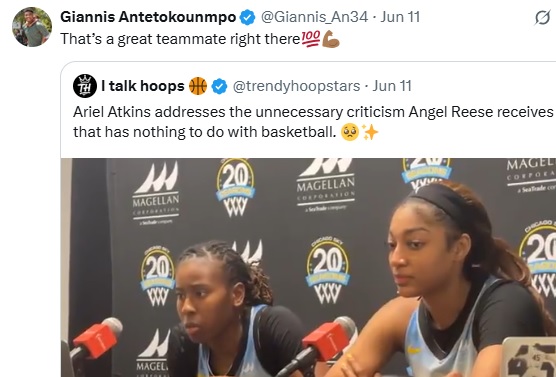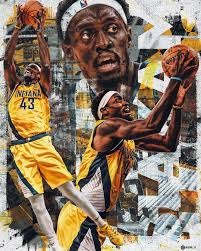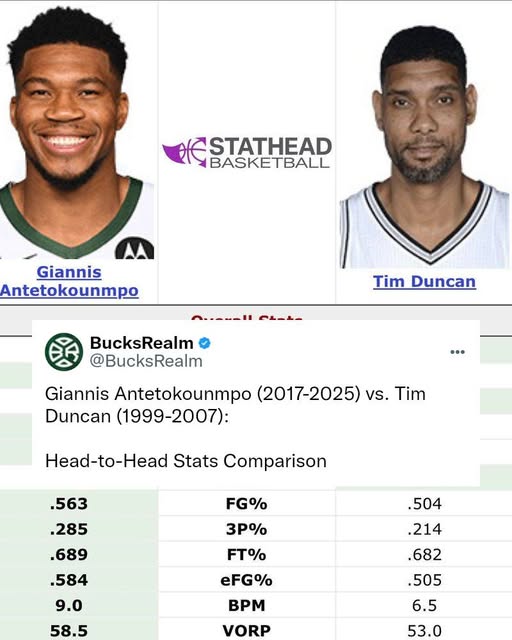Giannis Antetokounmpo, the Milwaukee Bucks’ two-time NBA MVP, and Angel Reese, the Chicago Sky’s rising WNBA star, may seem worlds apart at first glance. One dominates the NBA with his towering presence, while the other is carving her name in the WNBA with relentless energy. Yet, a closer look at their playing styles reveals striking similarities in how they impact the game, alongside shared limitations that shape their development. Giannis’ recent tweet “That’s a great teammate right there” mirrors the way the Bucks have always covered for him and his many many limitations.
1. Lack of a Reliable Jump Shot
The most glaring limitation for both Giannis and Reese is their underdeveloped jump shooting. Giannis’s career 28.6% three-point shooting and 53.4% free-throw percentage expose him in playoff scenarios, where defences sag off to clog the paint. His mid-range game has improved, but it’s still inconsistent. Reese faces a similar critique, shooting just 31% from the field, with most attempts near the rim. Her lack of a jumper limits her offensive versatility, forcing her to rely on put backs or drives.
Without a reliable shot, both players struggle against packed defences. Giannis often faces “walls” in the postseason, while Reese’s misses close to the rim have sparked memes and criticism. Improving their shooting is critical to unlocking their full potential.
2. Inefficiency in Scoring
Tied to their shooting woes, both players can be inefficient scorers. Giannis’s 55.3% true shooting percentage is solid but dips in high-stakes games when his jumper falters. Reese’s 30.9% field goal percentage in 2025 is among the league’s lowest, with analysts like Jason Whitlock slamming her “unskilled” offence. Her tendency to chase “mebounds” by missing layups and grabbing rebounds can inflate her stats but hurt team efficiency.
Both are working to address this—Giannis through mid-range development, Reese through finishing drills—but their current reliance on athleticism over finesse caps their scoring upside.
3. Decision-Making Under Pressure
While both show play making promise, (which never materialises) their decision-making can falter in crunch time. Giannis’s turnover rate (3.0 per game) spikes when defences blitz him, as seen in playoff losses where he struggles to read double-teams. Reese, still early in her career, has been criticised for forcing shots or holding the ball too long, as seen in a viral clip where she ignored open teammates. Her 0-for-8 night against the Liberty underscored this issue.
Maturing as decision-makers will help both maximise their impact, especially in high-pressure moments. And while Reese still has time, Giannis probably can’t and never will.
4. Media and Public Scrutiny
Though not a playing limitation, both face intense off-court pressure that shapes their growth. Giannis has navigated trade rumours and criticism of his playoff performances, yet remains a vocal leader. Reese endures relentless scrutiny, from her shooting struggles to her persona, with teammate Ariel Atkins noting her “heavy crown.” Giannis’s six-word praise for Atkins—“That’s a great teammate right there”—shows his empathy for Reese’s challenges.
This shared experience of handling “nonsense” criticism, as Atkins put it, highlights their resilience but also the mental toll of stardom. They seem insecure about their abilities and rightly so.
Reese may improve. Giannis? Probably not.
Reese’s work on finishing, as seen in training videos, mirrors Giannis’s efforts to refine his jumper. Both are young—Giannis at 30, Reese at 23—with room to grow. Giannis Antetokounmpo and Angel Reese share a dynamic, paint-centric playing style defined by rebounding, defensive versatility, and relentless energy. Their ability to attack the rim, handle the ball, and disrupt opponents makes them unique, but their lack of a jump shot and scoring inefficiency pose challenges. As they navigate media scrutiny and high expectations, their resilience and work ethic shine through, much like their on-court hustle.
For Giannis, the next step is playoff consistency; for Reese, it’s offensive polish. Yet, their similarities—rooted in athleticism, versatility, and heart—make them compelling figures in basketball’s evolving landscape. As Reese grows, her trajectory may echo Giannis’ rise from raw talent to superstar, proving that limitations are merely stepping stones for those who refuse to stop grinding. Will she be as lucky as Giannis in a championship run?
Sources:


